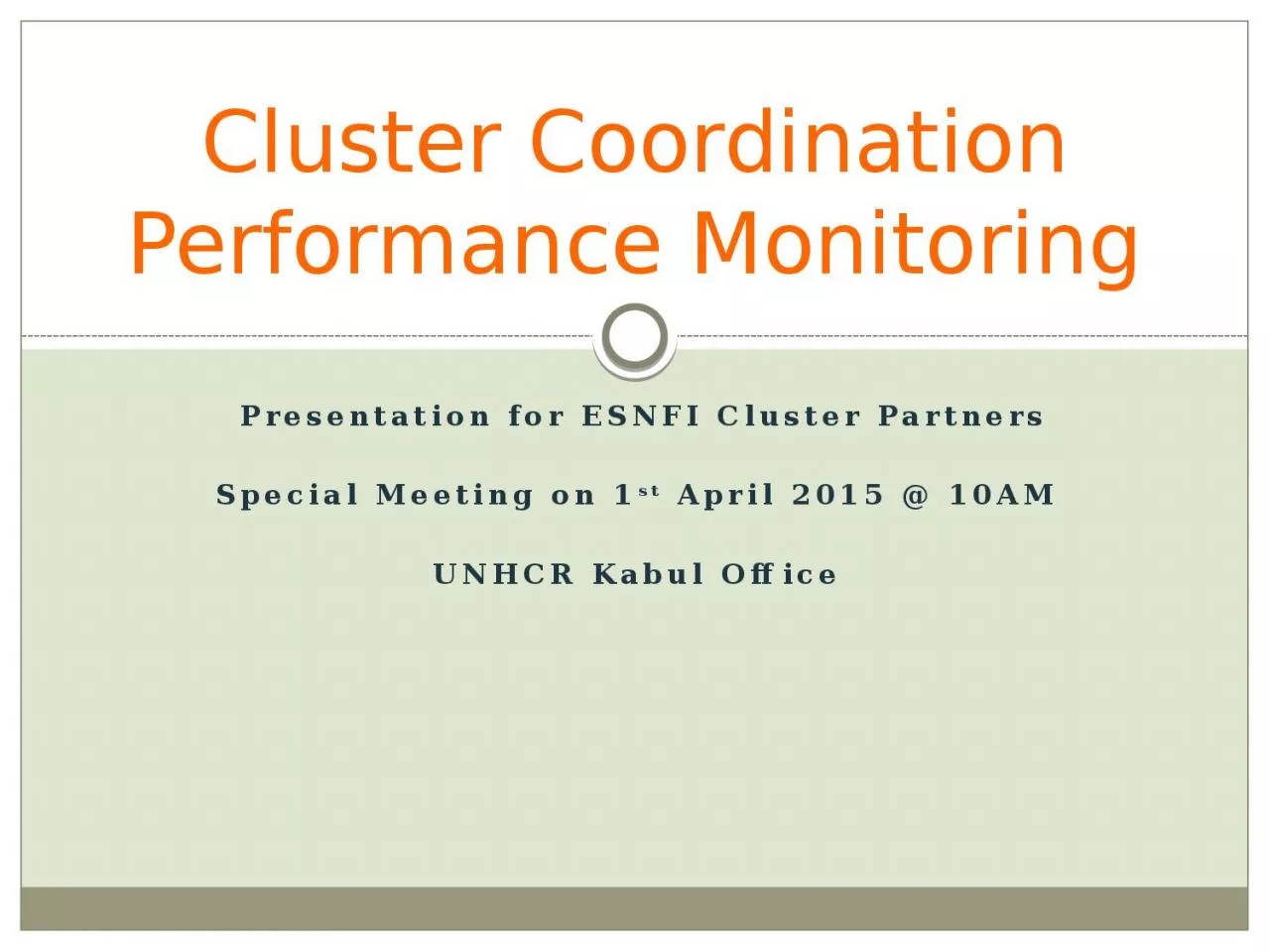

Special Meeting on 1 st April 2015 10AM UNHCR Kabul Office Cluster Coordination Performance Monitoring What is the CCPM A selfassessment of cluster performance against the 6 core cluster functions and Accountability to Affected populations ID: 919212
Download Presentation The PPT/PDF document "Presentation for ESNFI Cluster Partners" is the property of its rightful owner. Permission is granted to download and print the materials on this web site for personal, non-commercial use only, and to display it on your personal computer provided you do not modify the materials and that you retain all copyright notices contained in the materials. By downloading content from our website, you accept the terms of this agreement.
Slide1
Presentation for ESNFI Cluster PartnersSpecial Meeting on 1st April 2015 @ 10AMUNHCR Kabul Office
Cluster Coordination Performance Monitoring
Slide2What is the CCPM?A self-assessment of cluster performance against the 6 core cluster functions and Accountability to Affected populations:support service delivery inform the HC/HCT's strategic decision-making
strategy development
monitor and evaluate
performance
capacity building in preparedness and contingency planning.
Advocacy
+ section on Accountability to Affected Populations
A country led process, supported by Global Clusters and OCHA
The CPM can be applied by both clusters and sectors
Slide3Where does the CCPM come from?Transformative AgendaImprove coordination and accountabilityDeveloped
by the IASC
SWG on
the Cluster
Approach and endorsed by the IASC WG in 2012
Piloted in 2012 and implemented from 2013 -
Slide4Why monitor cluster coordination performance?Ensure efficient and effective coordination
Take stock of what functional areas work well and what areas need improvement
Raise awareness of support needed from the HC/HCT, cluster lead agencies, global clusters or cluster partners
Opportunity for
self-reflection
Strengthening
transparency and partnership within the cluster
Show the added value and justify the costs of coordination
Slide5The CCPM does not ………Monitor response (service delivery)
Evaluate individual partners or coordinators
Evaluate if/when clusters should be deactivated, merged etc. (Review of the cluster architecture)
Exclude usage of other tools with the same purpose
Slide6When to implement the CCPM?Protracted crises: Annually, but clusters decide when to implement itNew emergencies: 3-6 months after the onset
and
once every year thereafter.
If
several
core
functions have been registered
as weak - more frequent
Avoid simultaneous
commitments (e.g. the Strategic Planning Process, donor visits etc
.)
Slide7Who is involved?Ideally all clusters (cluster coordinators &
partners
)
Global Clusters: Technical and facilitation support
OCHA-HQ: provide Technical and facilitation support upon request / when clusters don’t hold the survey tool themselves
OCHA-FO coordinate across
clusters
(
ICCT)
and
ensure engagement of HC/HCT
Slide8CCPM in steps
Slide9Step I: PlanningHCT decision on CCPM timeframe and participation
Inter-cluster Coordination Group discussion
Each cluster meets to:
Discuss the
CCPM
purpose, process, methodology and outputs;
Clarify timeframe for;
Survey start and end dates (app. 2 weeks)
Circulation of Preliminary
Coordination Performance Report
and the Cluster Description Report.
Cluster meeting to finalise the Coordination Performance Report (contextualise), including developing the Action Plan
Clarify role of government counterpart
Establish commitment to follow-up on agreed actions to improve performance
.
Output I: Agreement on implementation and timeframe
Slide10Step II: The SurveyThree online
questionnaires:
The Cluster Description Report, completed by the
cluster
coordinator
Coordination performance questionnaire, completed by the cluster coordinator, app. 20-25 min
Coordination performance questionnaire, completed by the cluster
partners,
app. 20-25
min
Important:
Responses
are
anonymous - but avoid sensitive comments
Important to fully complete the questionnaire
Survey results
only shared externally after the cluster has contextualised it
.
Slide11Step II (continuation): The Survey
Example of survey question:
‘Has
your organization been involved in the development of the strategic plan
?’
☐
No strategic plan (NA)
☐
My organization was not asked to be involved
☐
My organization was asked to be involved but has not contributed
☐
My organization was asked to be involved, has contributed but contribution not adequately taken into account
☐
My organization was asked to be involved, has contributed and contribution somewhat adequately taken into account
☐
My organization was asked to be involved, has contributed and contribution adequately taken into account
Slide12Step II (continuation): The SurveyAnalysis and
scoring
of performance status
The median score for each
sub-category
is calculated based on aggregated results of partners and coordinator.
The median score is classified into a
4 categories of performance
status:
Score
Performance status
>0.75%
Green = Strong
0.51-0.75%
Yellow = Satisfactory (needs
minor improvement
0.26-0.50%
Orange = Unsatisfactory (needs major improvement
≤ 0.25%
Red = Weak
Slide13Step II (continuation): The SurveyOutput II: The survey results are weighted and compiled into a report
Slide14Step III: Cluster Analysis and Action Planning
Review/amend
the Cluster Description
Report
Explain/contextualize findings
Identify actions
for improvement (focus
on weak
and
unsatisfactory performance), timeframe and responsible for follow-up
Pinpoint
support requirements
**
Clusters can request the secretariat of the
Global
C
lusters
or OCHA-HQ for facilitation
support **
Slide15Step III (continuation): Cluster Analysis and Action Planning
Output III: Final CCPM and Action Plan
Actions for improvement, timeframe and responsible for follow-up
Awareness
of support requirements (HC/HCT, Cluster Lead Agencies, Partners, OCHA, Global Clusters and national authorities)
Shared with the HC/HCT and Global Cluster and, if applicable, the
National
A
uthorities
Slide16Step IV: Follow-up & Monitoring Follow-up:ICC: Review
of Reports/Action Plans identify
common weaknesses
to
be addressed
systematically.
HCT: Presentation
of
Reports/Action
Plans
and discussion of support requirements
Monitoring:
Take stock of progress at monthly cluster meetings
Quarterly progress reporting to the HCT
Output IV: Quarterly reports to HCT